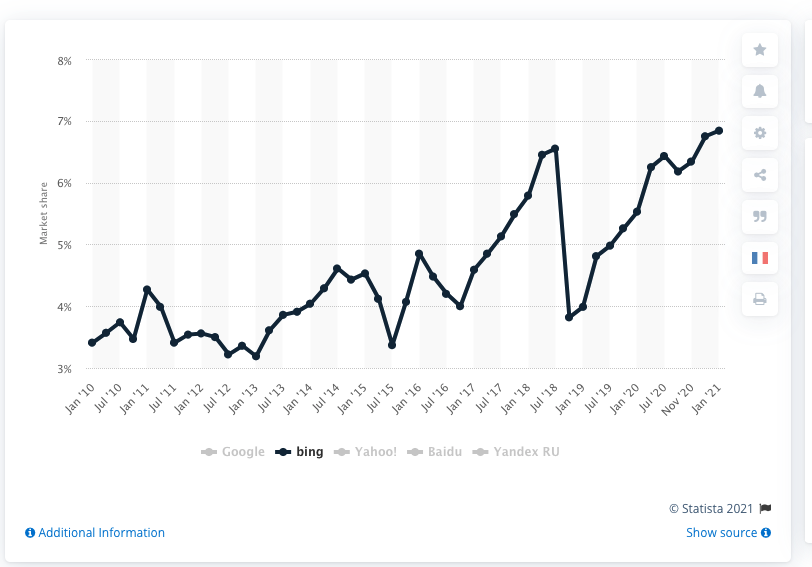Posted by
Liraz Postan
SEO takes on a major role in the world of digital marketing.
When we think of SEO, though, Google seems to be the first thing that comes to mind. For those of you who might have forgotten – Google isn’t the only search engine out there.
Microsoft’s Bing, for instance, is the second most used search engine in many countries worldwide. According to Statista – Bing captured 6.5% of the global search market in July 2020.

This number alone is one of the many reasons why Bing might be your go-to SEO strategy platform.
Not convinced yet?
According to ComScore, traffic converts better at Bing’s Network and their audience spends 6.8% more money online than Google searchers.
No matter where your loyalty lies, through this blog post we’ll get deeper into the advantages of Bing SEO.
Before we get into the SEO aspect, let’s get properly acquainted with Bing and what it can do for your online business.
What You Should Know About Bing
Since its launch in 1998, Bing has successfully controlled around 40% of the US desktop search market. The search engine mainly markets across the US and other English-speaking countries, with numbers indicating a sizeable crowd searching day in and day out.
This brings us to the question – who are the people who use Bing?
Statistics show that the typical Bing user has a higher education degree, a household income of over $70,000, and aged 35 to 54. The Bing-driven individual further spends more time on pages and sites and visits more affiliate links.
Additionally, Yahoo is powered by Bing, so if you take up the challenge to optimize for Bing, you’ll be killing two birds with one stone.
This brings us to the platform SEO, and if you know anything about Google optimization, doing the same on Bing will be a breeze.
In fact, all you have to do is keep in mind the slight differences between the two and you’re ready to go.
Let’s go through the key SEO aspects Bing provides.
The Ins And Outs of Bing SEO
The best part of optimizing on Bing is that, unlike Google, this search engine is an open book when it comes to sharing its SEO requirements. So, instead of playing a guessing game, SEOs are fully aware where they need to put in more effort.
For those who don’t want to lose any time away from Google optimization, the good news is that you won’t.
While optimizing for Bing, you’ll be, in a way, optimizing for Google as well. All you need to do to achieve that is set your priorities before you turn over a new leaf.
Bing Webmaster Tools
The first step towards increasing your site traffic is using Bing Webmaster Tools.
This webmaster area allows you to analyze your search performance through several key entities:
- Backlinks
- Keyword Research
- SEO Report
- Site Scan
By properly using Bing Webmaster Tools, you’ll be able to know the exact amount of clicks your page gets from its search engine. These aside, you can also get insights on the top keywords from organic searches your site ranks for.
Similarly, you’ll get insights on domains, referring pages, and anchor texts.
Last but not least, the site-scan feature crawls your site, analyzing it for common technical SEO issues.
The Bing Webmaster Tool is truly an incredible feature that can make your SEO experience a smooth sail.
Bing Rank Tracking
Although Bing Webmaster Tools is a great tool, it has its limits. However, a good rank tracker can fill these gaps.
For instance, if you want to use it as a rank tracking tool, you might find the ranking data a touch confusing. The reason is it doesn’t show you a daily ranking position.
Instead, it shows an average position. Average position is confusing because it is based on an average position for the time period you are looking at as well as an average of all the queries you are presenting.
This means, for instance, if you are looking at a seven-day period, you will get a different average rank than if you look at a three-month period. This makes understanding your rankings difficult.
You can easily solve this with a rank tracker.
For instance, when setting up a campaign in the Rank Ranger rank tracker, you can choose which search engines you want to track.
If you track Bing, you’ll get accurate ranking data comparing daily, weekly and monthly data.
To do that, go to the campaigns settings and click the Search Engines tab.
![]()
Once you have an overview of your SEO position, let’s move forward and go local.
Local Optimization
Local optimization is important for the overall SEO outcome.
Bing Places delivers local search results to its users, so listing your business on the platform should be a priority, especially if you want to be ahead of the game.
For Bing Places, reviews play a big role in terms of your business getting noticed.
It’s worth mentioning that the platform displays reviews from third-party sites as well.
Using Bing Places is an effective start to amping up your SEO.
Content is King
When I say content matters, I mean unique, authoritative, and meaningful content.
Duplicating your content won’t do you any favors with SEO, and if you’re throwing in too many ads that are consistently redirecting people – successful indexing on Bing will be a farfetched concept.
Make sure that the content you’re putting out is of great value and engages the readers. When citing, ensure to mention the source and author, thus bringing more authority and trust into the content.
Structure and format is another thing you should pay a lot of attention to. The ideal blog post length is around 2000 words – enough for you to introduce much-needed flair fit for a superb SEO piece.
The efforts don’t stop here, so let’s move on to further optimization and using backlinks.
Backlinks
When it comes to linking, it is quite similar to content creation – quality is crucial.
You might be in trouble if your site has links coming from irrelevant or spam websites, and the same applies to paid links.
Instead of these two, emphasize anchor text enriched with densely set keywords.
Bing also appreciates having an extensive amount of links – as long as they come from trustworthy websites.
That brings up the question – which websites are authoritative for Bing?
Links from sites labeled as organic, such as .edu, .org, and .gov domains will help your site index better. Additionally, getting your links on older websites is an effective strategy because Bings reads the domain’s age both as trustworthy and authoritative.
Finally, driving traffic from social media promotion is significant for Bing SEO, but before we dive deeper into it, let’s pay attention to another major factor – on-page SEO.
On-Page SEO
The most important thing you should know about Bing SEO is that it reads and prioritizes content with exact keyword matching in:
- Titles of pages; keep it 60 characters max
- Meta descriptions; keep it 150 characters max
- Web content
Another aspect that can help your on-page SEO is using keywords in headings, subheadings, URL slugs, and in the first paragraph of the content.
Furthermore, you should be aware that Bing also prioritizes domains with the exact keyword match. This doesn’t mean that you should change or adapt your domain based on this fact, but keep it in mind for more thorough SEO projects.
The Influence of Social Media

Bing has been open on the importance of social media linking when it comes to its SEO.
The search engine will index websites with social media links that drive valuable traffic. The same rules apply to social media, whose links Bing finds authoritative and trustworthy.
Another point in your SEO to-do list should be earning likes, shares, and tweets, especially if you want your site moving up a page.
No worries, this strategy isn’t as time-consuming as you think.
Today, there is an endless spectrum of tools that listen and help you find relevant conversations connected to your business. Always remember that your social presence should align with your target audience. For this reason, ensure your social media profiles reach the right audience.
Finally, it is wise you produce meaningful content for your social media as well – otherwise, irrelevant content won’t provide you with the desired results.
Mobile Optimization
According to WebFX, people spend 70% of their time on their smartphones, whilst 52.2% of all website traffic is generated from mobile phones.
Therefore, adapting your site and making it mobile-friendly plays a vital role in Bing SEO.
The search engine can read whether your site is open for mobile users, but it’s of utmost importance to avoid mobile-specific URLs. Instead, you can use the same URL for both desktop and mobile apps.
The Power of Understanding Entity

Today, visual search is booming, especially in the SEO game.
No doubt, Bing is the leader in this field with its unique feature – entity-understanding.
The search engine can understand what your search is about, and shows you images based on that. To top it all off, Bing uses high-quality images as part of its algorithm.
Aside from images, the search engine can accurately crawl audios, videos, and Flash websites. It isn’t advisable to go with just Flash websites though but focus on the quality of your remaining multimedia content instead.
With that being said, adding quality content can help immensely in boosting your site’s rating and relevance.
Why Bing?
Most websites optimize with Google, completely neglecting other search engines.
Search engines like Bing, therefore, become environments of low competition, performing within the same market.
The demographic of Bing is both more ****** and allows users to spend more money on bigger results. So, if you’re doing business online, this is the search engine you might want to turn to instead.
Of course, we cannot shun the fact that the typical Bing user is more likely to bring more traffic and give more value to your content.
Time-wise, it won’t take you a lot to reach solid optimization. You’ll get an advantage because of Bing’s policies and open conversations about SEO requirements.
While optimizing for Google is important, as is its aim, Bing grants opportunities for all business ****** online – and with far less fuss than its competitors.

